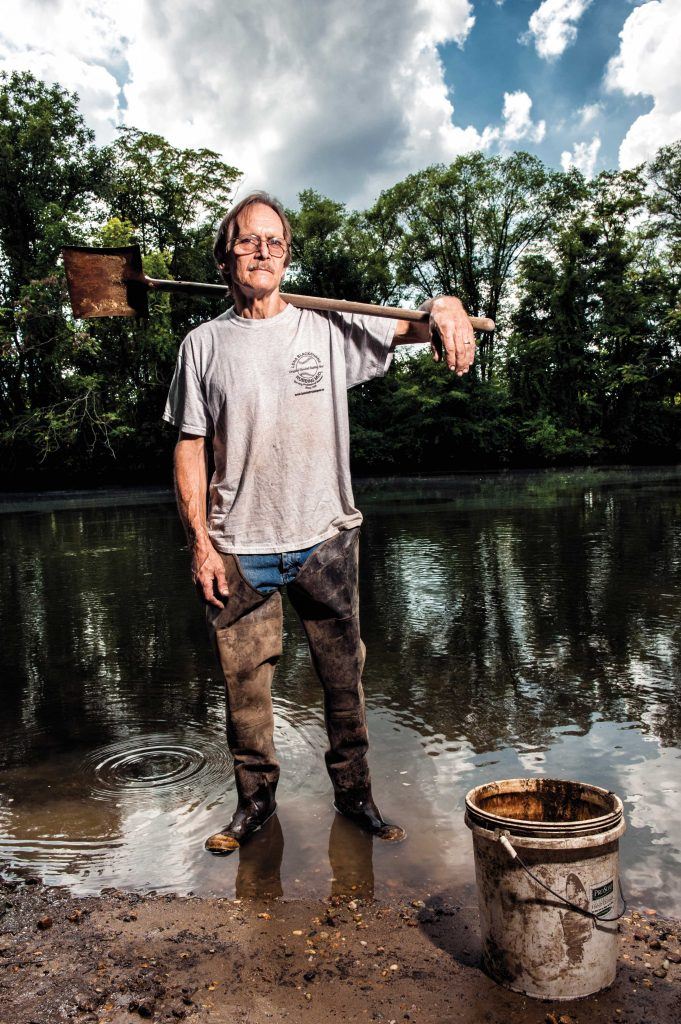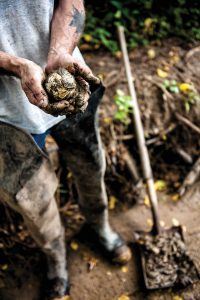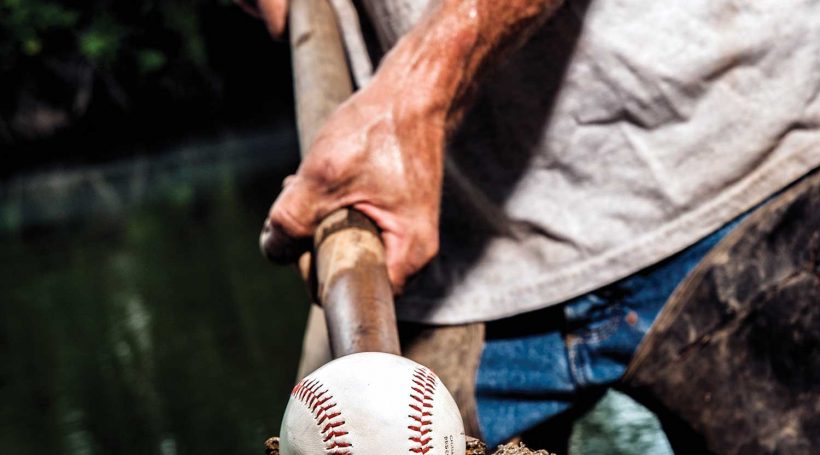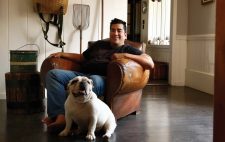 Jim Bintliff has mud under his fingernails. That’s because the official rules of Major League Baseball call for new balls to be “properly rubbed so that the gloss is removed.” To do that, all MLB teams rub their baseballs with one particular type of mud, and Bintliff is the only guy who knows where to find it – not far from his home in Delran.
Jim Bintliff has mud under his fingernails. That’s because the official rules of Major League Baseball call for new balls to be “properly rubbed so that the gloss is removed.” To do that, all MLB teams rub their baseballs with one particular type of mud, and Bintliff is the only guy who knows where to find it – not far from his home in Delran.
Major and minor league baseball teams have used Lena Blackburne Baseball Rubbing Mud from Palmyra since 1939. Brand new balls arrive shiny and white from the factory, and they’ll slide right out of a pitcher’s hand. To take the slippery sheen off, players tried rubbing the balls with infield dirt, tobacco juice and shoe polish, but it was never quite right. Tobacco juice stained the balls, and dirt scratched them up so they wouldn’t fly straight.
In 1910, Lena Blackburne, a lifelong Burlington County resident, became the first member of the Palmyra Field Club to play in the Major Leagues. By 1938, he was coaching third base for the Philadelphia Athletics and listening to umpires complain about the baseballs they inspected before every game.
Blackburne remembered a childhood swimming hole in a Delaware River tributary near Palmyra where you’d sink up to your knees in mud. He scooped up some of that thick, dark mud and brought it back to the ballpark, where it worked like a charm. The mud took the sheen off the balls without leaving deep stains or scratching the leather. The players and umpires loved it, and the Lena Blackburne Baseball Rubbing Mud Company was born. Within a few seasons, the Philadelphia Athletics and the rest of the American Association teams were using that mud to prepare their game balls. Their opponents in the National League tried to get their hands on the mud as well, but Blackburne stood his ground.
“The honest truth is he would not sell it to the National League,” Bintliff says. “Before Major League Baseball, the World Series was like a prizefight between the American Association and the National League. To Lena, it would’ve been a betrayal. It stayed that way until 1950, when he was hired as a scout for the Phillies. Then, of course, the National League was allowed to use the mud.”
Bintliff’s maternal grandfather, John Haas, was Blackburne’s childhood best friend. When the mud business took off, Haas was the only person Blackburne trusted with the location of his secret spot. When Blackburne died in 1968, Haas inherited the company.
“The first time I remember helping with the mud, I was about 7 years old helping my grandfather,” Bintliff says. “And soon he passed it on to my parents, and all through my teen years and into my 20s, I helped my father.”
Bintliff has fond memories of those days on the Delaware with his parents and eight siblings. “On weekends in the fall we’d go out on a boat to get to the spot,” he says. “We’d play around, water ski, have a picnic lunch and wait for low tide. When the tide went out we’d pull up, jump out and grab the mud.”
Bintliff’s father was a steeled war veteran; a Navy man who kept his mouth shut about the mud. Bintliff says the reason for his father’s staunch silence was simple: “It was the mud.”
In 2000, Bintliff’s parents retired and he stepped up, took over the family business and gained a new perspective. “It didn’t dawn on me until I finally took over the reins how unique the business is,” he says. “I suppose I always knew it was different, but I was so young and I guess I just saw it as something we did.”
Now Bintliff runs the company with help from his wife Joanne and his daughters Abbie and Rachel. In the past 75 years, he says, things have changed.
The mud now comes packaged in a clean white plastic tub – a departure from the recycled coffee cans neighbors used to leave on the family’s porch.
“When I was a kid we used the coffee cans,” Bintliff says. “We’d paint them silver, fill them with mud, put the lid back on with duct tape and send them off.”
That iconic packaging is gone but not forgotten; in 1969 a can was placed in the Baseball Hall of Fame as part of an “evolution of the ball” exhibit. Bintliff was only 15, but he remembers the induction ceremony well, including meeting baseball legends Stan Musial, Roy Campanella and Sandy Koufax.
There have been other changes over the years as well. Bintliff’s father restricted sales of the mud to major and minor league professional teams. But Bintliff sells the mud via the company’s online store to anyone with $24, the cost of a “personal size” tub.
The most expensive tub of mud, the 4-pound “professional size,” costs $75.
Bintliff says total annual sales hover somewhere around $30,000 – enough to provide Joanne with “spending money,” but not enough to quit the overnight printing press job he’s had for 30 years.
“I’m not getting rich,” Bintliff says. “People say I should be getting rich, but that’s not why we do it. It’s just a tradition. I do make more money off it than my father did, because we sell to international leagues, colleges, high schools and the public, but we still don’t do any advertising.”
Bintliff goes out to the tributary six or seven times a year, but he doesn’t use a boat. Now he drives his beat-up truck out to a certain point, then hikes through the woods, with five-gallon buckets and shovel in tow. Once in a while, he’s not the only person at his secret spot.
“If I see people, and there have been occasions where people have been there fishing, they always ask me what I’m doing,” Bintliff says. “I tell them I use the mud in my garden on my rose bushes, or I have some fun and tell them I am doing a geological study for the Delaware River Commission.”
Though much has changed, there are some important aspects of the mud operation that Bintliff says aren’t going anywhere. One of those aspects is the process he uses to prepare the mud for use.
 “I like to compare it to aging wine,” he says. “It has to settle, and I try to get rid of as much water as I can.”
“I like to compare it to aging wine,” he says. “It has to settle, and I try to get rid of as much water as I can.”
The aging process takes about a year, and the mud settles in buckets in Bintliff’s backyard and laundry room. Once it’s been cured, Bintliff’s kids chip in, filling tubs and slapping on labels that shout “Baseball’s Magic Mud.”
And perhaps it is magic. Bintliff seems to think so. He says the magic comes from a perfect, unlikely marriage of “geology and geography.”
“There’s a lot of clay in the soil and a lot of feldspar, which is probably the biggest natural ingredient,” he says. “It’s in the quartz family, and it’s a super fine grit. That’s probably what does most of the work to take the sheen off a baseball without scratching the leather. And it’s the geography too; it has to come from a certain bend in the tributary, so it has the right settling properties.”
Bintliff says he’s allowed scientific studies to be done on the mud, and he’s even taken a few reporters to the spot – blindfolded, of course. In 2005, Bintliff and the mud were featured on the pilot episode of Discovery Channel’s “Dirty Jobs.”
While he’ll always be tight-lipped about the exact location of the tributary, he doesn’t worry about imitators. In fact, he says sporting-equipment manufacturer Rawlings once tried to reproduce the mud and failed.
“They paid a farmer to try to reproduce it, and they made a bunch and couldn’t sell it because it didn’t work right,” Bintliff says. “They ended up giving it away with their buckets of practice balls.”
Even if Bintliff’s secret spot were discovered, he has confidence in the staying power of a well-known name.
“The tradition is what matters, because the trademark is everything,” he says. “Somebody could go to the same spot and get the same mud and put their name on it, and it would never be Lena Blackburne Baseball Rubbing Mud.”
While Bintliff has no plans to expand, growth seems to be happening naturally. In the last five years, he says, NFL teams have begun contacting him to buy tubs of mud.
“Apparently brand-new footballs are slippery just like baseballs,” Bintliff says. “They always took them and rubbed them into the ground to take the shine off, but now with Astroturf they can’t do that. We have a lot of college football teams asking about it too, so that may be the new trend for football.”
With his business on the upswing, Bintliff knows he won’t be able to shovel mud forever. Now in his 60s, he admits the work is getting a little too heavy for him to do alone. He’s not worried about the future of the mud, though. He already knows his younger daughter Rachel, 22, will eventually take over.
Bintliff says his mother let him know when he was 15 years old that he’d be the one to take over when his parents retired.
“I didn’t know why she picked me,” Bintliff says. “I was in the middle of nine siblings, and I even left the state for a few years in my late teens, but she knew instinctively that I’d be back. And I was. I came back because it’s Jersey, and you always come back to Jersey.”
Bintliff says he came to understand his mother’s intuition when his own children were adolescents.
“I just always knew it would be Rachel. The same way my mother knew it would be me, I guess,” Bintliff shrugs. “I know she’ll never leave the area. She wants to get married and be a teacher in the school she graduated from. She’ll raise her own family within five miles of this house.”
When Bintliff harvests the mud now, it is often with the help of Rachel’s longtime boyfriend Zach, whom he calls “her future husband,” with a knowing, fatherly smirk, though the two are not yet engaged.
As he nears retirement age, Bintliff says he finds comfort in the mud. He draws pleasure from the knowledge that his mud plays a part in every legendary home run, and now, quite a few impressive touchdown plays.
“When I watch them throw the ball I know it’s got my mud on it,” he says. “It’s awesome.”
Bintliff says he’ll keep going out to get the mud for as long as he can, if only for the quiet moments of reflection he gets when he’s out in the reeds, shovel in hand.
“Every time I go out I think about Lena Blackburne and my grandfather, and I remember the first time I did it,” he says.
“I think about all the times going out with my dad and my family, and about how eventually my grandchildren will be here doing this. It’s one of the last great traditions, and it’s been kept secret all this time. The mud is a beautiful thing.”












